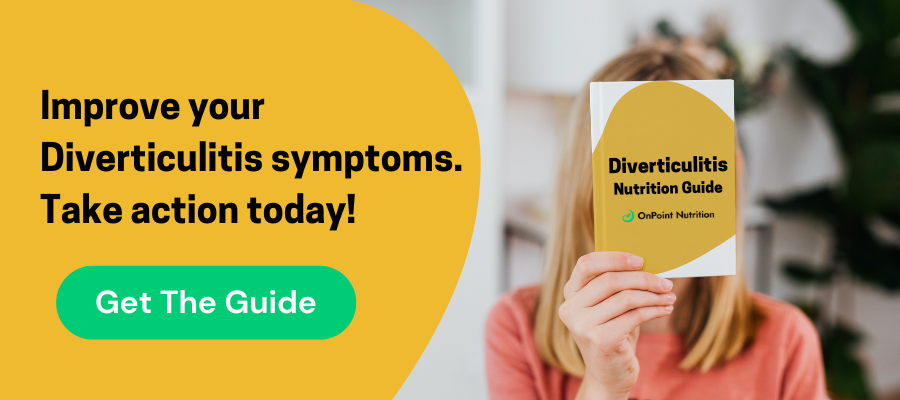
Diverticular disease has two phases: a dormant phase and an active phase. Diverticulosis is characterized by the formation of small, bulging pouches called diverticuli in the intestine. Diverticulitis is the condition's active form. Diverticulitis occurs when the pouches in your colon become infected or inflamed. Diverticulosis is actually a fairly common condition; 35% of the US population has it.
However, less than 5% of these people will experience diverticulitis in their lifetime. Because it is rarely expressed, most people with Diverticulosis will never even know they have it! For those of you who have Diverticulosis, there are a few dietary recommendations that will help prevent diverticulosis from progressing to diverticulitis. These recommendations also align with our general recommendations for a healthy, balanced diet.
The Key Ingredient: Fiber
Our recommendations really focus on one key nutrient…fiber! The USDA’s fiber recommendation for adults is 25-30 grams per day. Despite this recommendation, research shows the average American adult only consumes 10-15 grams of fiber per day, less than half of the recommended amount!
Not eating enough fiber puts you at a much higher risk of developing Diverticulitis. Fiber helps to add bulk to your stool, which allows it to pass quickly and easily. This detail is important because constipation and straining during bowel movements can make your condition worse. Below are some easy tips for adding more fiber to your diet.
Eat whole fruits and vegetables instead of juice
Whole fruits and vegetables contain substantially more fiber than fruit juice itself. Most dietary fiber is found in the skin and the flesh of the fruits and vegetables, which is what is removed when extracting juice. For example, a whole orange contains about 3 grams of fiber, while one juiced orange contains only 0.5 grams.
Leave the skin on fruits and vegetables
Fruits and vegetables with the skin-on contain more fiber than their skinless counterparts. Researchers believe the difference can be up to 33% more for the skin-on version.
Read food labels
Whole foods are the best way to get fiber. However, when choosing packaged foods, look for brands that are rich in fiber. Some packaged foods even have fiber added to them, which is typically advertised on the product package. Any product containing 2.5 grams of fiber per serving is considered a “good” source, and anything with 5 grams or more per serving is considered “excellent”.
Choose whole grains
Whole grains are significantly higher in fiber than refined grains. During the refining process, the two parts of the grain that contain most of the nutrients, the bran and germ, are removed. The refined product is lower in overall nutrients and fiber. You will find examples of whole grains below.
If needed, take a fiber supplement
If you are eating a balanced diet rich in fruits and vegetables, you shouldn’t need to take a fiber supplement. However, some people can benefit from trying psyllium husk, Metamucil, or something similar. Be careful when adding a fiber supplement, though, as dramatic increases in fiber can cause discomfort.
The best way to increase your fiber intake is through whole foods. The list below highlights the foods with the highest fiber content. Choose a variety of these foods to incorporate into your daily diet.
Fruits: Pears, Strawberries, Avocado, Apples*, Raspberries, Bananas, Blueberries, Blackberries
Vegetables: Carrots, Beets, Broccoli, Artichoke, Brussels Sprouts, Kale, Spinach, Tomatoes
Legumes: Lentils, Kidney Beans, Black Beans, Split Peas, Chickpeas, Edamame, Lima Beans, Quinoa
Grains: Quinoa, Oatmeal, Brown rice, Whole Wheat Pasta, Barley, Oat Bran*Apples are generally considered good for diverticulitis. They are a good source of dietary fiber, which plays a crucial role in maintaining digestive health and preventing constipation. High-fiber foods, like apples, can help soften stools and promote regular bowel movements, reducing the risk of diverticulitis flare-ups. While apples are generally well-tolerated, however they are also a high FODMAP item depending on what variety (Granny Smith is a good example of a Low FODMAP choice), so some individuals with diverticulitis may experience discomfort or digestive issues after consuming them.
For more information on how to manage a diverticulitis flare and improve your diet to deal with your diverticulitis, download our Diverticulitis Nutrition Guide.
Topics

Kaitlyn Willwerth is a Registered Dietitian at OnPoint Nutrition. Kaitlyn's work focuses on providing individualized health and lifestyle coaching and, most importantly, support. She is a Certified LEAP Therapist and has also completed the Monash University 'Low FODMAP Diet for IBS' online training course for health professionals.





